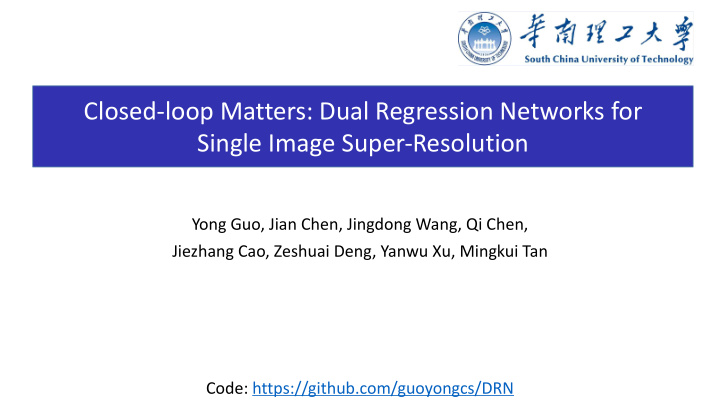



Closed-loop Matters: Dual Regression Networks for Single Image Super-Resolution Yong Guo, Jian Chen, Jingdong Wang, Qi Chen, Jiezhang Cao, Zeshuai Deng, Yanwu Xu, Mingkui Tan Code: https://github.com/guoyongcs/DRN
Motivation Limitations of existing SR methods n The space of the possible functions that map LR to HR images is extremely large because infinitely many HR images can be downsampled to the same LR image n It is hard to obtain a promising SR model when the paired data are unavailable n It is hard for existing methods to find a good solution due to the large space of possible mapping functions n SR models often incur a severe adaptation problem and yield poor performance on unpaired real-world data
Dual Regression Scheme Our method n We propose a novel dual regression scheme that can reduce the possible function space to enhance the performance of SR models Figure 2. Dual regression training scheme, which contains a primal regression task for super-resolution and a dual regression task to project super-resolved images back to LR images
Dual Reconstruction Network (DRN) Figure 3. The architecture of DRN for 4 × super-resolution n DRN contains a primal network and a dual network (marked as red lines) n The primal module follows the downsampling-upsampling design of U-Net n The dual module has two convolution layers and a LeakyReLU activation layer
Training Methods for Paired Data Given paired data, the model is trained by minimizing Eqn. (1) under the learning scheme of supervised SR methods: (1) Notation n 𝒚 " , 𝒛 " donate the 𝑗 -th pair of low- and high-resolution images n ℒ ' , ℒ ( are the loss function (L1-norm) for the primal and dual tasks n λ controls the weight of the dual reconstruction loss
Adaptation Algorithm on Unpaired Data Our method n We propose an efficient adaptation algorithm to adapt SR models to the unpaired LR data Given both unpaired data and paired data, the model is trained by minimizing Eqn. (2): (2) Notation n 1 * + (·) is an indicator function that equals to 1 when 𝐲 𝐣 ∈ 𝑇 ' ( 𝑇 ' is paired dataset), and otherwise the function equals 0
SR tasks with paired Bicubic data n DRN-S with about 5M parameters yields promising performance n DRN-L with about 10M parameters yields the best performance
SR tasks with paired Bicubic data (a) Visual comparison for 4 × super-resolution (b) Visual comparison for 8 × super-resolution Figure 4. Visual comparison of different methods for 4 × and 8 × image super-resolution n Our model consistently produces images with sharper edges and shapes, while other baselines may give more blurry ones
SR tasks with unpaired data n DRN-Adapt outperforms the baseline methods on unpaired synthetic data Figure 5. Visual comparison of model adaptation to real-world video frames (from YouTube) for 8 × SR n DRN-Adapt produces visually promising images with sharper and clearer textures
Conclusion n We propose a theoretically guaranteed dual regression scheme that can reduce the possible function space to enhance the performance of SR models n We propose an efficient adaptation algorithm to adapt SR model to unpaired real-world data, such as raw video frames from YouTube n Extensive experiments on both paired and unpaired data demonstrate the superiority of DRN over the considered baseline methods Code: https://github.com/guoyongcs/DRN
Recommend
More recommend